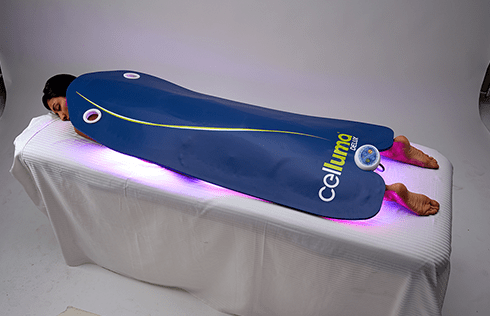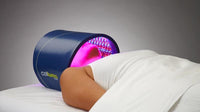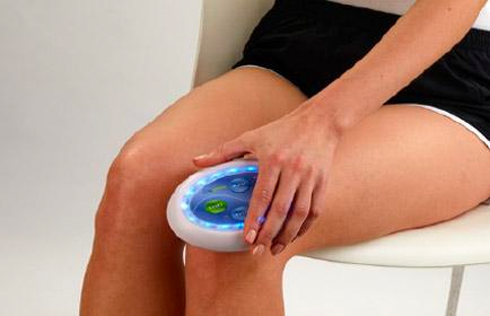Should You Expect Side Effects from LED & Red Light Therapy?

Low-level light therapy (LLLT) delivery by high intensity light emitting diodes (LEDs) is a well-proven science and a popular trend in medical aesthetics and pain management circles today. Advances in LED technology has improved dramatically in recent years and, consequently, light therapy devices are more affordable and more versatile than ever. Medical practitioners and families alike are using LED light therapy to improve health and treat a wide range of conditions from skin concerns to musculoskeletal pain with little or no side effects when used according to the manufacturer’s instructions. While negative side effects are not a concern, you should always familiarize yourself with the contraindications associated with using light therapy to ensure the best outcomes for your patient’s or your family’s health.
Along with these advances in technology and continued research comes the good news that there are, in fact, minimal side effects from using LED red light therapy. And red light therapy devices are not just limited to improving skin health on just the face. With the development of full-body light therapy devices, the benefits of modern user-friendly light therapy devices are now available to address and improve whole body health and wellness. Light therapy is great for pet health too!
While selecting the appropriate light therapy machine may seem overwhelming, it doesn’t have to be! There are established and simple guidelines to ensure a well-informed decision. If you are a skin care professional specializing in skin health, a well-chosen device will yield a quick return on investment, optimize client outcomes, increase referrals and enhance the bottom line of your practice through increased services and sales. And if you are an at-home light therapy user just looking to improve your skin health, the health of your family, or deal with chronic pain, these same principles can help you make smart buying decisions as well.
To begin with, put your mind or your client’s concerns to rest by choosing a light therapy device that is FDA-cleared. This means that the device has been reviewed for both efficacy and safety. The cleared indications-for-use should be relevant to the conditions you wish to address. For example, if you own an anti-aging clinic but the device is only cleared for acne then this is not the device for you. Or, if you are looking to clear up your skin from severe acne but the device is only cleared from pain, then you have wasted your money. Remember, there are little or no negative side effects from using light therapy but you do need to make sure the device has the ability to address your specific skin and health concerns.
Look for an efficient, multi-purpose light therapy device. Just like smartphones, LED devices today have become multi-functional, lightweight and streamlined. Whether deciding between a panel-style or a handheld LED, modern devices are designed for efficiency and can address a variety of skin and health conditions with a single machine, thereby minimizing your investment and requiring minimal storage space.
In order for a light therapy device to be effective, a specific amount of light energy must reach the target tissue to achieve favorable clinical outcomes. When selecting a light therapy device, there are several factors to consider which impact the cell’s ability to absorb the emitted energy:
a) Choose a light therapy device emitting evidence-based wavelengths; blue, red and near-infrared. These wavelengths have been widely shown to increase ATP production in cells which are compromised due to aging, illness, disease or just poor lifestyle choices. Blue light addresses acne issues, while red and near-infrared decrease inflammation and increase micro-circulation to bring more oxygen and nutrients to the area. In aesthetics, red and near-infrared are particularly desirable for their ability to stimulate fibroblast activity and boost collagen and elastin production. The only side effect is healthy, glowing skin! No other wavelengths are more broadly supported in credible scientific research.
b) The efficaciousness of a light therapy session depends on the amount of energy absorbed by the cells. Therefore, it is prudent to choose a flexible LED array system which can contour closely to the treatment area for optimal energy absorption. Laws of optical physics have established that the closer the light therapy device is positioned to the skin, the more energy is absorbed. A flexible panel device with a large treatment area, has the distinct advantage over rigid light therapy delivery systems where the distance between the light source and skin is difficult to keep constant, leading to inconsistent light absorption. While handheld light therapy devices are ideal for spot treatment and are normally used directly on the skin, they lack efficiency due to the small treatment area.
c) It is well known that the beneficial effects (again, no side effects!) resulting from LED light therapy require a specific energy delivery. The correct parameters will result in processes known to promote anti-aging, enhance wound healing, reduce pain and improve skin health including acne, as well as other clinical benefits. The acceptable range of energy available for absorption at or close to the surface of the skin, for an effective LED light therapy device, is measured in Joules and should be in the range of 2-10 J/cm2.
d) Pulsing adds a higher level of sophistication and effectiveness to an LED light therapy device and its importance is often overlooked. Delivering the light energy in a pulsed manner has been shown in the clinical literature to enhance the cell’s ability to absorb more energy over the treatment period. For better pain and skin outcomes, choose a device that offers pulsing as an option.
In closing, a light therapy device that contours closely to the surface of the skin, can be used effectively anywhere on the body, including over the face as well as wrapped around body parts for the treatment of a wide variety of skin and pain issues. Used as a treatment enhancing add-on or as a stand-alone treatment, LED offers something for every aesthetic and pain practitioner as well as their clients and patients alike without the harmful side effects often associated with other more ablative modalities. Still have questions? Speak with a qualified and trained light therapy specialist who can guide you on the best light therapy device to meet your family’s health and wellness needs.
















